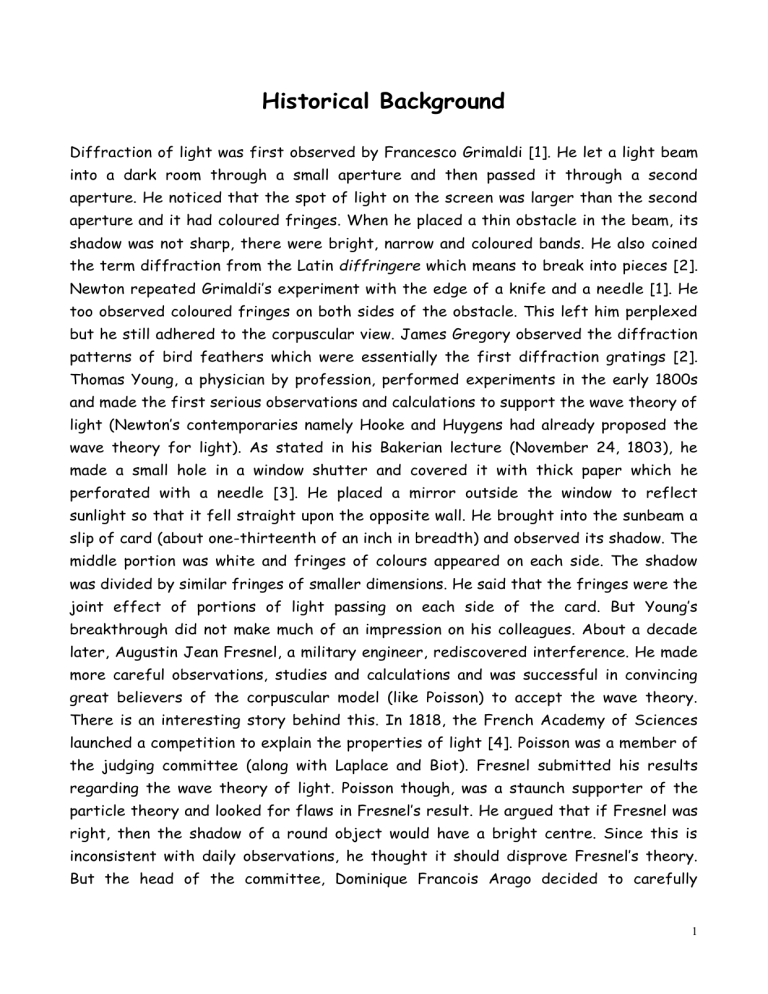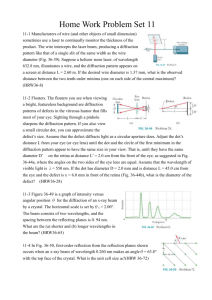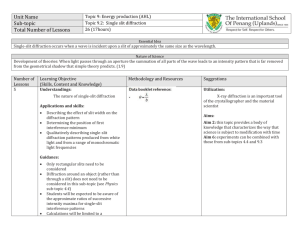Diffraction report 3 2015 mac

Historical Background
Diffraction of light was first observed by Francesco Grimaldi [1]. He let a light beam into a dark room through a small aperture and then passed it through a second aperture. He noticed that the spot of light on the screen was larger than the second aperture and it had coloured fringes. When he placed a thin obstacle in the beam, its shadow was not sharp, there were bright, narrow and coloured bands. He also coined the term diffraction from the Latin diffringere which means to break into pieces [2].
Newton repeated Grimaldi’s experiment with the edge of a knife and a needle [1]. He too observed coloured fringes on both sides of the obstacle. This left him perplexed but he still adhered to the corpuscular view. James Gregory observed the diffraction patterns of bird feathers which were essentially the first diffraction gratings [2].
Thomas Young, a physician by profession, performed experiments in the early 1800s and made the first serious observations and calculations to support the wave theory of light (Newton’s contemporaries namely Hooke and Huygens had already proposed the wave theory for light). As stated in his Bakerian lecture (November 24, 1803), he made a small hole in a window shutter and covered it with thick paper which he perforated with a needle [3]. He placed a mirror outside the window to reflect sunlight so that it fell straight upon the opposite wall. He brought into the sunbeam a slip of card (about one-thirteenth of an inch in breadth) and observed its shadow. The middle portion was white and fringes of colours appeared on each side. The shadow was divided by similar fringes of smaller dimensions. He said that the fringes were the joint effect of portions of light passing on each side of the card. But Young’s breakthrough did not make much of an impression on his colleagues. About a decade later, Augustin Jean Fresnel, a military engineer, rediscovered interference. He made more careful observations, studies and calculations and was successful in convincing great believers of the corpuscular model (like Poisson) to accept the wave theory.
There is an interesting story behind this. In 1818, the French Academy of Sciences launched a competition to explain the properties of light [4]. Poisson was a member of the judging committee (along with Laplace and Biot). Fresnel submitted his results regarding the wave theory of light. Poisson though, was a staunch supporter of the particle theory and looked for flaws in Fresnel’s result. He argued that if Fresnel was right, then the shadow of a round object would have a bright centre. Since this is inconsistent with daily observations, he thought it should disprove Fresnel’s theory.
But the head of the committee, Dominique Francois Arago decided to carefully
1
perform the experiment. He molded a 2mm metallic disc to a glass plate with wax. He succeeded in observing the spot predicted by Poisson (it had previously been observed by Delisle and Maraldi). This convinced most scientists of the wave nature of light.
Fresnel eventually won the prize.
Theory
Wikipedia definition:
Diffraction refers to various phenomena which occur when a wave encounters an obstacle or a slit. In classical physics, the diffraction phenomenon is described as the interference of waves according to the Huygens Fresnel principle.
Hyperphysics definition:
Diffraction manifests itself in the apparent bending of waves around small obstacles and the spreading out of waves past small openings
Fig 1: Schematic diagram of experimental setup
2
Formula used:
y
Lm d
: wavelength of light
L: distance of screen (wall in my case) from the slits d: distance between the slits m: order of the fringe (bright) y: distance of the particular order of bright fringe from the centre
Derivation of the formula:
Note: I came up with this derivation on my own in class 11. It involves too much of algebra. A much simpler and elegant proof exists in Dr HC Verma’s book “Concepts of
Physics”.
Fig 2
3
From fig. 2,
𝐵𝐶 − 𝐴𝐶 = 𝜆
(The path difference is for the first bright fringe)
⇒ √[𝐿 2 + (𝑦 + 𝑑
2
)
2
] − √ 𝐿 2 + (𝑦 − 𝑑
2
)
2
= 𝜆
⇒ 𝐿√[1 + (
2𝑦 + 𝑑
2𝑙
)
2
] − 𝐿√[1 + (
2𝑦 − 𝑑
2𝑙
)
2
] = 𝜆
⇒ √ [1 + (
2𝑦 + 𝑑
2𝑙
)
2
] − √ [1 + (
2𝑦 − 𝑑
2𝑙
)
2
] = 𝜆
𝐿
⇒ [1 +
1
2
× (
2𝑦 + 𝑑
2𝑙
)
2
] − [1 +
1
2
× (
2𝑦 − 𝑑
2𝑙
)
2
] = 𝜆
𝐿
(for small x, (1 + 𝑥)
1
2
= 1 + x/2)
⇒
(2y + d) 2 − (2y − d)
8L 2
2
=
λ
L
⇒
(2𝑦 + 𝑑 + 2𝑦 − 𝑑)(2𝑦 + 𝑑 − 2𝑦 + 𝑑)
8𝐿
= 𝜆
[ 𝑎 2 − 𝑏 2 = (a + b)(a − b)
]
⇒ (4𝑦)(2𝑑) = 8𝜆𝐿
⇒ 𝑦 = 𝜆𝐿 𝑑
For m other than 1,
𝑦 = 𝜆𝐿𝑚 𝑑
4
Procedure and Experimental Setup
All the experiments described were performed by me at my home.
The experimental setup was pretty simple (fig. 3). A laser pointer was placed in a thermocol casing which was stuck on a cardboard box. A pocket was made in front of the box using a sheet of paper. The paper was stuck on all three sides except the top
(allowing me to keep the slits in it). This pocket served to hold the slits. Once a particular slit was placed in the pocket, it was adjusted so that the laser beam fell directly on it. This setup was placed at a distance of about 2m from a wall and the diffraction pattern was observed on it. A Nikon D90 DSLR camera was used for taking photographs.
Fig 3: Experimental setup for diffraction
The slits that I have made will be discussed in the next section.
Later, I was intrigued as to how Thomas Young performed his experiment without any laser or any modern day equipments. I learnt that sunlight was his source of light. He let it fall on a screen through a pinhole in the window shutter. He brought into the beam a slip of thin card. This inspired me to reconstruct the experiment using sunlight. So I covered up the windows with black chart papers (got a great deal of scolding from my mother for doing this) and made a small circular hole in it (fig. 4). I tried reflecting the light using a mirror so that it fell straight on the opposite wall but the intensity was greatly reduced. I simply put one of my slits in front of the hole and
5
tried to obtain its diffraction pattern on paper (fig. 5). The results were not quite satisfactory though.
Fig 4: Covered window
Fig 5: Spot made by sunlight through the hole on the screen
5a) Without the slit 5b) With the slit
6
Fig 6: Sunlight diffraction using TEM grid
7
My Initial Attempts on Diffraction
In this section I will deal with the various types of slits I have used and the diffraction patterns obtained from them.
Firstly, I simply cut a slit using a paper cutter in a sheet of card. The results were not satisfactory.
Fig 7a: single slit in a sheet of card Fig 7b: Diffraction pattern
Fig 8a: pinhole in a sheet of card Fig 8b: Diffraction pattern
8
Then, I used 0.5mm pencil leads and placed them as close as I could. I got a better pattern but still, the fringes were not very clear or distinct (fig. 8).
Fig 9a: pencil lead slit Fig 9b: Diffraction pattern
Later, I tried cutting slits and making pinholes in an aluminium foil. The single and double slit patterns looked terrible but the circular aperture gave decent results.
Fig 10a: single slit in foil Fig 10b: Diffraction pattern
Fig 11a: pinhole in foil Fig 11b: Diffraction pattern
9
At this point, I was running out of ideas and was on the verge of giving up when I came across a website [5] suggesting that a hair strand could be used as a barrier.
This gave excellent results.
Fig 12a: hair strand Fig 12b: Diffraction pattern
My mother got some TEM grids from her lab and I tried flashing the laser through it and observed the pattern. It was simply fascinating.
Fig 13a: TEM grid Fig 13b: Diffraction pattern
10
Here is a compilation of the various other things whose diffraction patterns I observed (edge of a sheet of card, bird feather, tissue paper and handkerchief).
Fig 14a: Card (from whose edge the diffraction pattern was observed)
Fig 14b: Diffraction pattern
(from the edge of the card)
Fig 15a: bird feather Fig 15b: Diffraction pattern
11
Fig 16a: Tissue paper Fig 16b: Diffraction pattern
Fig 17: Diffraction pattern of a handkerchief
I finally decided to use the hair strand and TEM grid to carry out simple calculations to find the diameter of a hair strand and the pitch of a TEM grid (distance between the centres of two successive wires which is the same as the sum of the hole width and the bar width).
12
Experiment 1: To measure the thickness of a hair strand through optical diffraction
COLOUR
OF LASER
𝜆
(m)
L
(m)
m
Y
(m)
d=
Lm/y
(m)
1 3 2.2 × 10 −2 7.25 × 10 −5
GREEN 5.32 × 10 −7 2 3 4.7 × 10 −2 6.79 × 10 −5
3 3 7.0 × 10 −2 6.84 × 10 −5
1 3 2.9 × 10 −2 6.72 × 10 −5
RED 6.50 × 10 −7 2 3 5.8 × 10 −2 6.72 × 10 −5
3 3 8.6 × 10 −2 6.80 × 10 −5
In this case, ‘d’ is the thickness of the hair strand (distance between two wide slits).
𝑚𝑒𝑎𝑛 𝑑 =
(7.25+6.79+6.84+6.72+6.72+6.80)×10
−5 m
6
≈
6.8 × 10 −5 m
Result: The mean thickness of the hair strand is 68µ
m
.
Note: In the third book of Newton’s Opticks, some observations are made regarding shadows of a hair. His value for the breadth of the hair he used was 1/280 inches which is approximately equal to
9.07 × 10 −5 m
.
13
14
15
Experiment 2: To measure the pitch of a TEM grid through optical diffraction
COLOUR
OF LASER
𝜆
(m)
L
(m)
m
Y
(m)
d=
Lm/y
(m)
1 3 1.2 × 10 −2 13.30 × 10 −5
GREEN 5.32 × 10 −7 2 3 2.6 × 10 −2 12.28 × 10 −5
3 3 3.9 × 10 −2 12.28 × 10 −5
1 3 1.4 × 10 −2 11.80 × 10 −5
RED 6.50 × 10 −7 2 3 2.1 × 10 −2 12.38 × 10 −5
3
In this case ‘d’ is the pitch of the TEM grid.
3 3.2 × 10 −2 12.19 × 10 −5
𝑚𝑒𝑎𝑛 𝑑 =
(13.30+12.28+12.28+11.80+12.38+12.19)×10
−5 m
6
≈
12.4 × 10 −5 m
Result: Mean pitch of the TEM grid is 124µ
m.
Note:
Specifications of the TEM grid used:-
Imported by Mars Scientific
200 mesh, Cu grid pitch: 125µm hole width: 90µm bar width: 35µm
16
17
18
Errors involved
As the experimental setup was pretty crude, errors in the measurement of lengths are bound to arise. Due to poor intensity, it was difficult to find out the exact point of maximum intensity and its distance from the centre. Only approximate measurements could be made. The lasers had an absolute error of 10nm (this is very minimal though and completely negligible compared to the error of about half a cm that I would have made while taking the readings). Also, an ordinary ruler was used which is accurate only upto 1mm. The diameter of hair may not be uniform throughout. In the circular aperture, the hole may not be perfectly circular, so concentric dark and bright circles were not seen (which should be the ideal pattern). The dust particles could spoil the
TEM grid and interfere with the experiment.
References
[1] Andrew Robinson, “The Last Man Who Knew Everything”, Oneworld Publications, Oxford,
2006
[2]: http://en.wikipedia.org/wiki/Diffraction
[3] Morris H. Shamos (ed), “Great Experiments in Physics” Dover Publications, 1987.
[4]: http://en.wikipedia.org/wiki/Arago_spot
[5]: http://physicsed.buffalostate.edu/pubs/StudentIndepStudy/EURP09/Young/You ng.html
Bibliography
D. Millar, I. Millar, J. Millar and M. Millar, “Chambers Concise Dictionary of Scientists”,
Cambridge University Press, 1989 (Pp 153-154, 413-414)
Websites: http://hyperphysics.phy-astr.gsu.edu/hbase/phyopt/diffracon.html http://www.studyphysics.ca/newnotes/20/unit04_light/chp1719_light/lesson58.htm http://www.studyphysics.ca/newnotes/20/unit04_light/chp1719_light/lesson59.htm http://www.princeton.edu/~rvdb/images/Questar/PoissonSpot.html http://spiff.rit.edu/classes/phys312/workshops/w9a/laser_expt.html
19








